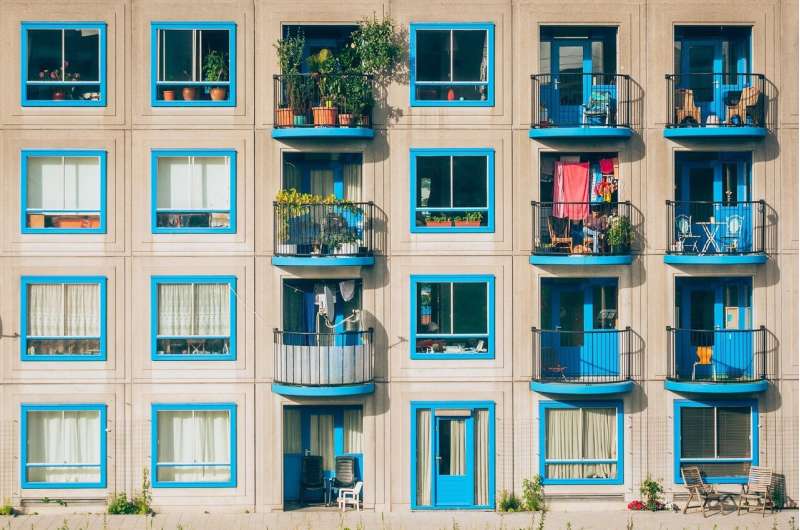Upgrade low-income housing to improve public health, the environment and racial equity all at once

During a presidential election debate on Oct. 22, 2020, former President Donald Trump . "They want to take buildings down because they want to make bigger windows into smaller windows," he said. "As far as they're concerned, if you had no window, it would be a lovely thing."
What a difference five months makes. While replacing your big windows with small ones is not on the Biden-Harris administration's agenda, increasing home energy efficiency is. Addressing these and other housing issues is critical for three of the new administration's : ending the COVID-19 pandemic, addressing climate change and tackling racial and economic inequality.
As an , I have studied ways in which inadequate housing influences health and disproportionately affects low-income families and communities of color. In my view, retrofitting low-income housing in particular is a high-leverage way to tackle some of our nation's most pressing health, social and environmental challenges.
Housing shapes everything
The pandemic has spotlighted how directly housing affects people's health. It's intuitively clear that physical distancing is hard if your family lives in a few rooms. And studies have shown that crowded indoor environments, including houses and apartments, are .
Housing also is a substantial contributor to climate change. come from residential energy use. Large homes generally use more energy, but lower-income homes are often less energy-efficient, which makes them costly to heat and cool.
One recent survey found that between spring 2019 and spring 2020, 25% of low-income American households . Families may be forced to to pay energy bills, or endure . As changing climate lengthens summer, and there are more scorching hot days, those who lack air conditioning or can't afford it are in danger.
Racial inequities in housing aren't random. For generations, kept Black and other minority households from purchasing homes in many neighborhoods. There are large racial gaps in both and the availability of high-quality housing across the country.
Potential policy solutions
Now, for all of these reasons, housing is in the political spotlight. The Biden-Harris presidential platform included . The new American Rescue Plan Act, which President Biden signed into law on March 11, includes meant to forestall an eviction crisis and to reduce energy insecurity. Secretary of Housing and Urban Development Marcia Fudge has pledged to .
These efforts are all related. Energy-efficiency investments in low-income housing have broad ripple effects, including financial relief for residents, lower carbon emissions and healthier indoor environments.
But there are key questions. Will agencies address these issues as siloed challenges or in an integrated way? And will federal leaders and members of Congress see strategic investments in housing as a strategy that offers broad societal benefits?
The state of low-income housing
demonstrates some of the challenges low-income households face. Many of the who live below the poverty line crowd into smaller, older homes. Often these dwellings have structural deficiencies like pest infestation, mold, peeling paint and exposed wiring.
Living in these environments creates from exposure to lead paint, allergens and indoor air pollution. The economic challenges of the pandemic, with people spending much more time at home, have heightened these risks.
Poor conditions also plague many chronically underfunded . Given how vulnerable many public housing residents are, I see upgrading these buildings as critical.
The benefits of energy efficiency
Well-designed energy-efficiency measures provide economic, health and climate benefits in single-family and multifamily homes, including in low-income housing. My research demonstrates both the promise and potential pitfalls of various measures.
For example, lowers electricity and fuel consumption. In turn, this saves money, improves outdoor air quality and reduces greenhouse gas emissions.
However, upgrades can be done well or badly. We found that weatherization alone, without other improvements, in low income, multifamily housing, especially in homes where people smoke or cook frequently with gas stoves. That's because steps like adding insulation and sealing cracks trap indoor air pollutants inside. Coupling weatherization with steps such as adding kitchen exhaust fans and high-efficiency particle filters in heating and air conditioning systems produces healthier results.
Are there win-win-win scenarios?
If better housing saves money, makes residents healthier and more comfortable, improves air quality, decreases greenhouse gas emissions and reduces racial disparities, why don't we have more of it?
One reason is that those who pay for improvements—landlords or government agencies—often aren't the ones who directly benefit from living in a less drafty home with cleaner air. Likewise, it's rare for health care providers to consider housing upgrades as an approved clinical intervention.
But that could change. A showed that providing stable, affordable housing improved physical and mental health for both children and adults. have been shown to , lessen asthma symptoms and reduce health care costs. Healthier kids miss less school and earn better grades.
Strategic federal investments could ultimately save taxpayers money and improve health. federal rental assistance—which helps families afford better housing—led to reduced emergency department visits for asthmatic children, saving money for the Medicaid system. Subsidized energy efficiency upgrades also increase property values, which helps address long-standing .
The Department of Housing and Urban Development typically gets little notice from the public, especially amid a global pandemic when Americans are focused on vaccinations and the economy. But Secretary Fudge has an opportunity to spotlight housing as a lever for improving health, the environment and economic and racial equity. All without shrinking anyone's windows.
Provided by The Conversation
This article is republished from under a Creative Commons license. Read the .![]()


















